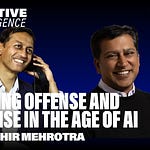You can see the Gen AI age everywhere—except in the productivity stats.
Sound familiar? This concern is older than you imagine. Back in 1987, economist Robert Solow famously observed, “You can see the computer age everywhere but in the productivity statistics.” It kicked off years of debate about the so-called IT productivity paradox. A similar debate is emerging about Gen AI.
In this episode of Creative Intelligence, I bring to you a live conversation from the 2025 Wharton Global Forum that was held in San Francisco. I sat down with Aparna Chennapragada (CPO, Microsoft), Sajjad Jaffar (Partner at GrowthCurve Capital), Xing Liu (HongShan Capital Group/formerly Sequoia China), Ramon Richards (CTO, T. Rowe Price), and Lin Yuan (CAIO, Newfront) to explore many questions that executives are now quietly asking, including the big one: Where is the ROI from Gen AI?
The Productivity Payoff Takes Time—and Transformation
The IT productivity paradox was a big research question for technology researchers in the 80s and 90s. By the late 90s, there was ample evidence of the productivity impact of IT and those findings are important today: the gains from IT investments came with a lag. The lag was partly because investments in IT alone weren't enough. One needed complementary resources like skilled labor and workflow redesign. In short, firms needed time to adapt, restructure, and learn. (there were other factors like measurement issues which is not my focus here) Fast forward to Gen AI in 2025. We are seeing interest and adoption at a rapid pace but ROI and productivity are still elusive.
If you're a CEO or CIO wondering where the payoff is—look beyond the tools alone. Invest in reskilling, rethink processes and workflows, and give your teams time to adapt.
Product Strategy and Moats in the AI Age
In a world where every competitor has access to the same foundation models, what’s defensible? Several of our guests converged on the same answer: data.
Lin emphasized the value of proprietary data in generating moats and also argued that vertical-specific models and domain-tuned data are a powerful edge, not just in quality but also in cost-efficiency.
Sajjad described data as a “latent off-balance-sheet asset” that is underutilized and underappreciated, but should be at the center of every successful AI strategy.
Aparna and I chatted about the broader product strategy. She warned: “Every few months, the model eats the product.” The best product strategy in her opinion is a “Thin product, thick model.” and building continuous feedback loop between the two. This is a big theme in my opinion, one that I hope to explore more deeply in a later episode.
We also discussed how can technology and product teams adapt to constant changes and model releases. Ramon emphasized the need for a modern architecture, sound data infra, and automated delivery practices in the tech org as important preconditions to react to this rapidly evolving space.
One-Person Unicorns—and the End of the Traditional Org Chart
Sam Altman predicted that “one-person unicorns” will emerge from agentic AI; tiny teams powered by massive intelligence. That future is already starting to show up in leaner early-stage AI startups.
“We’ll have to rethink everything we teach in business school about org behavior, leadership, and people management.”
— Xing Liu, on the implications of agentic AI
If AI reshapes the firm, then business education must adapt with it. Leadership might become less about managing massive teams. Management theory may have to grapple with humans managing human and non-human teams.
My Reflection
We often overestimate short-term impact and underestimate long-term transformation.
Just as IT reshaped firms but the impact was seen in decades, Gen AI is unlikely to move the productivity needle until other pieces such as redesigned workflows and upskilled talent are in place.
Too bad, there is no plug-and-play ROI.
Preview of the next episode: I just recorded an episode with Prof Anil Seth who studies the biological basis for consciousness. He and I discussed whether AI can be conscious, the defining traits of sentient machines, and the ethical implications. That was a fun conversation and I’m excited to bring it to you in two weeks.
Timestamps
0:00 – Introduction
3:05 – Beyond AGI: Intelligence Overhang and the Infrastructure Gap
9:32 – ROI, Pattern Matching, and What Makes AI Valuable Today
15:45 – From Products to Systems: Rethinking Software in a Model-First World
23:28 – Data as Differentiator: Memory, Moats, and Domain-Specific AI
30:52 – Organizational Shifts: Data Culture, Change Management, and the New Stack 36:18 – One-Person Unicorns, Global Teams, and Agent Collaboration
39:50 – Competing in the Age of Giants: How Startups Can Win
43:04 – Regional Dynamics: Global Networks and the Open-Source Moment
46:05 – The Talent Revolution: Skills That Will Define the Next Decade
50:46 – Interoperability and the Cost of Lock-In
53:20 – Value, Risk, and Society: Who Gains, Who Loses?
57:48 – Closing Remarks & Conclusion
As always, I’d love to hear your thoughts. Share them below.











Share this post